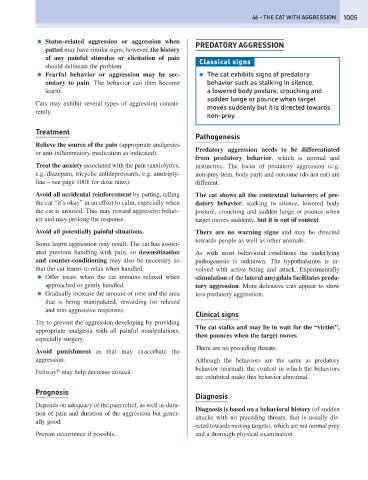Page 1013 - Problem-Based Feline Medicine
P. 1013
46 – THE CAT WITH AGGRESSION 1005
● Status-related aggression or aggression when
PREDATORY AGGRESSION
patted may have similar signs, however, the history
of any painful stimulus or elicitation of pain
Classical signs
should delineate the problem.
● Fearful behavior or aggression may be sec- ● The cat exhibits signs of predatory
ondary to pain. The behavior can then become behavior such as stalking in silence,
learnt. a lowered body posture, crouching and
sudden lunge or pounce when target
Cats may exhibit several types of aggression concur-
moves suddenly but it is directed towards
rently.
non-prey.
Treatment
Pathogenesis
Relieve the source of the pain (appropriate analgesics
Predatory aggression needs to be differentiated
or anti-inflammatory medication as indicated).
from predatory behavior, which is normal and
Treat the anxiety associated with the pain (anxiolytics, instinctive. The focus of predatory aggression (e.g.
e.g. diazepam, tricyclic antidepressants, e.g. amitripty- non-prey item, body part) and outcome (do not eat) are
line – see page 1001 for dose rates). different.
Avoid all accidental reinforcement by patting, telling The cat shows all the contextual behaviors of pre-
the cat “it’s okay” in an effort to calm, especially when datory behavior, stalking in silence, lowered body
the cat is aroused. This may reward aggressive behav- posture, crouching and sudden lunge or pounce when
ior and may prolong the response. target moves suddenly, but it is out of context.
Avoid all potentially painful situations. There are no warning signs and may be directed
towards people as well as other animals.
Some learnt aggression may result. The cat has associ-
ated previous handling with pain, so desensitization As with most behavioral conditions the underlying
and counter-conditioning may also be necessary so pathogenesis is unknown. The hypothalamus is in-
that the cat learns to relax when handled. volved with active biting and attack. Experimentally
● Offer treats when the cat remains relaxed when stimulation of the lateral amygdala facilitates preda-
approached or gently handled. tory aggression. More defensive cats appear to show
● Gradually increase the amount of time and the area less predatory aggression.
that is being manipulated, rewarding for relaxed
and non-aggressive responses.
Clinical signs
Try to prevent the aggression developing by providing
The cat stalks and may lie in wait for the “victim”,
appropriate analgesia with all painful manipulations,
then pounces when the target moves.
especially surgery.
There are no preceding threats.
Avoid punishment as that may exacerbate the
aggression. Although the behaviors are the same as predatory
behavior (normal), the context in which the behaviors
®
Feliway may help decrease arousal.
are exhibited make this behavior abnormal.
Prognosis
Diagnosis
Depends on adequacy of the pain relief, as well as dura-
Diagnosis is based on a behavioral history (of sudden
tion of pain and duration of the aggression but gener-
attacks with no preceding threats, that is usually dir-
ally good.
ected towards moving targets), which are not normal prey
Prevent occurrence if possible. and a thorough physical examination.

